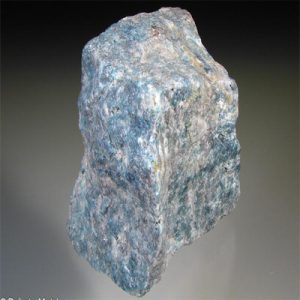Trolleite (incl.)
Trolleite is a rare phosphate mineral that is unusually hard at about 8.5 on the Mohs scale. It was originally named by Blomstrand in 1869 for Hans Gabriel Trolle-Wachmeister (1782-1871), a Swedish chemist. It was discovered at a small iron ore deposit at Västanå Iron Mine (Westanå Mine), Skåne, Sweden. Trolleite is often associated with other phosphate minerals such as Augelite, Lazulite, Montebrasite and Scorzalite. Trolleite is found in colors of light to pale green, colorless, bluish green, bright blue (dark blue when included) and may be very blue because of mixtures with Lazulite orScorzalite.
A recent find of Quartz containing heavy inclusions of Trolleite and Lazulite was presented for the first time at the 2011 Tucson Gem Show. This new material is from Minas Gerais, Brazil and was submitted to the Mineralogical Museum of the University of Rome as well as the Italian National Research Counsil’s Institute of Environmental Geology in Rome for standard gemological testing techniques as well as testing by a Camaca SX-50 electron microprobe. This testing identified the blue inclusions in Quartz as Trolleite and Lazulite. This new material from Brazil is translucent to opaque with fairly even light to medium blue color.
Distribution: At the Type Locality in Sweden, from the Västanå mine, near Näsum, Skäne; also at Hälsjöberg, Värmland; from Hökensås, Västergötland. A recent find from Minas Gerais, Brazil. In the Buranga pegmatite, Rwanda. On Mt. Perry, 75 km southwest of Bundaberg, Queensland, Australia. In the USA, at the Kyanite Corporation mine on Willis Mountain, Buckingham County, Virginia; four km west of Glendevey, Larimer County, Colorado; in the Champion mine, White Mountains, Mono County, California.
| Chemical Formula: | Al4(PO4)3(OH)3 |
| Aluminum Phosphate Hydroxide | |
| Molecular Weight: | 443.86 gm |
| Composition: | Alumium | 24.32 % | Al | 45.94 % | Al2O3 |
| Phosphorus | 20.93 % | P | 47.97 % | P2O5 | |
| Hydrogen | 0.68 % | H | 6.09 % | H2O | |
| Oxygen | 54.07 % | O | |||
| 100.00 % | 100.00 % | = TOTAL OXIDE |
| Crystallography: | Monoclinic – Prismatic |
| Crystal Habit: | Lamellar, massive, to 3 cm |
| Twinning: | None |
| Cleavage: | Poor/Indistinct in two directions |
| Fracture: | Irregular/Uneven, Sub-Conchoidal |
| Tenacity: | Brittle |
| Moh’s Hardness: | 8.5 |
| Density: | 3.08 (g/cm3) |
| Luminescence: | Not fluorescent |
| Radioactivity: | Not Radioactive |
| Color: | Light or pale Green, Colorless, Bluish Green, bright Blue (dark Blue when included). May be very blue because of mixtures with Scorzalite. |
| Transparency: | Transparent to Translucent |
| Luster: | Vitreous |
| Refractive Index: | 1.619 – 1.643 Biaxial ( – ) |
| Birefringence: | 0.024 |
| Dispersion: | Weak to Strong; r > v or v < r |
| Pleochroism: | None |


